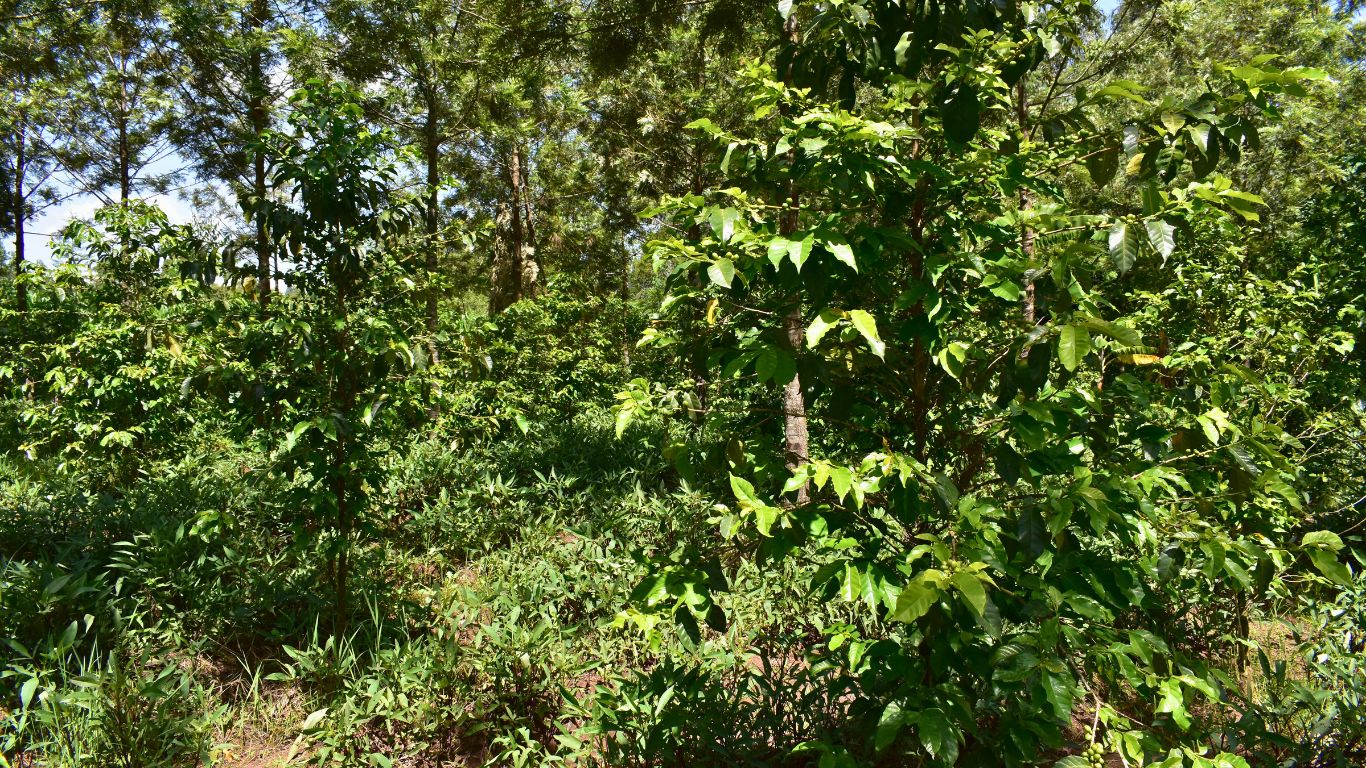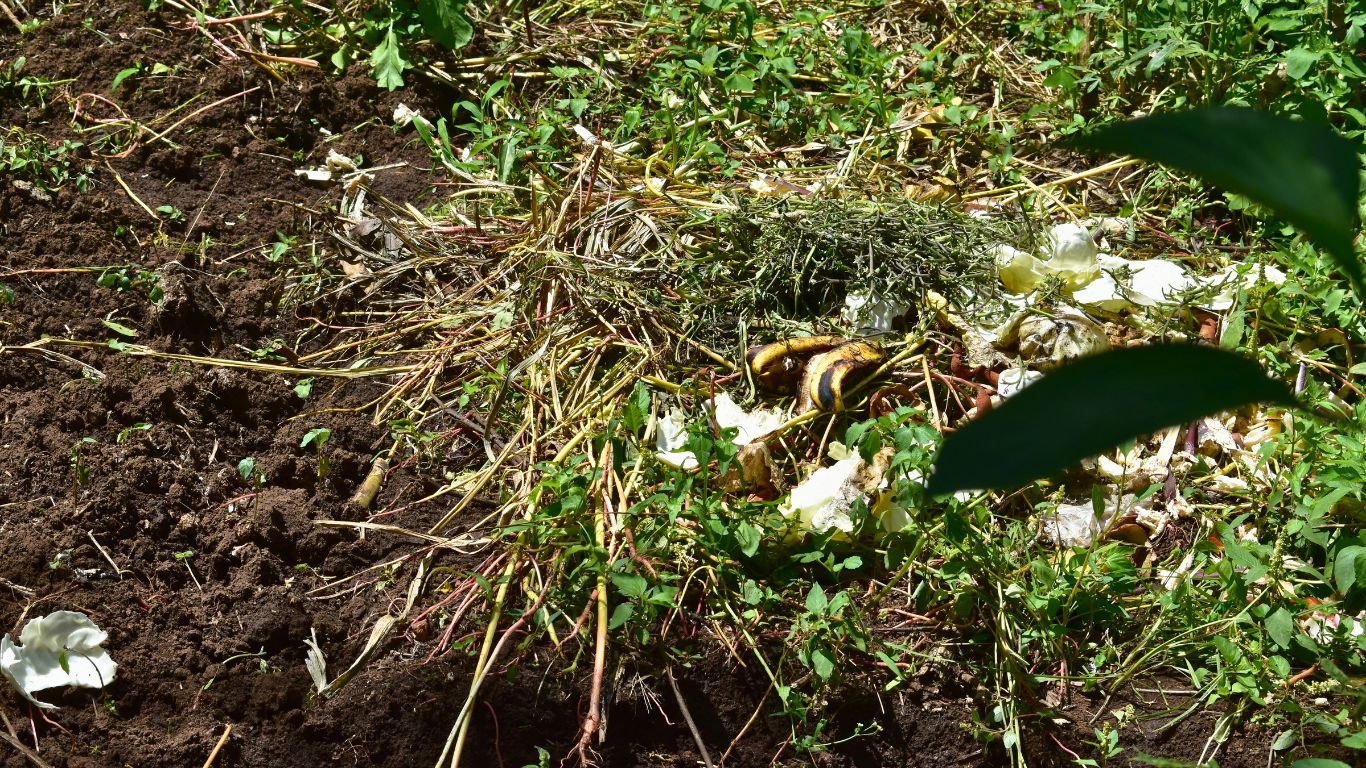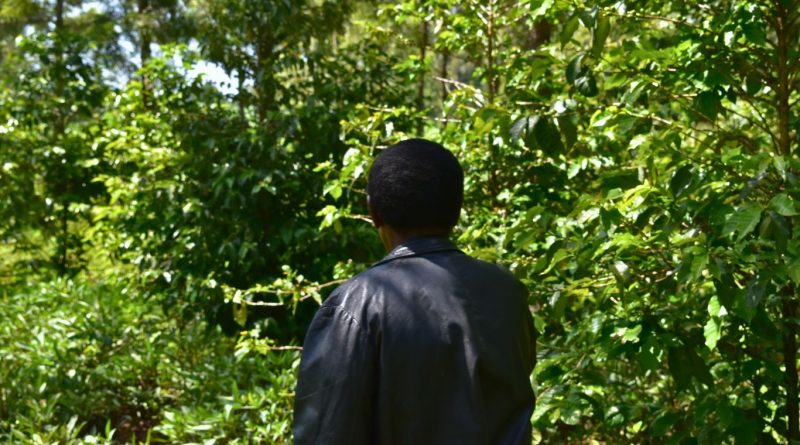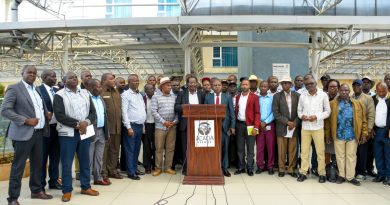How a Rural Woman Healed Her Soil — and Herself
Uasin Gishu, Kenya — As the first light of morning breaks over the gentle flow of the Chepkoilel River in Sokyot Village, Turbo Constituency, Loyce Chelimo, 64, starts her morning milking cows, releasing free-range chickens, and walking through her four-acre farm. On her arable farm, grevillea trees line the footpaths, sweet potatoes and beans snake between cassava and millet, while coffee, fruit trees, and indigenous vegetables flourish with the seasons.
Chelimo, a retired administrator and mother of three, has been cultivating this land in Uasin Gishu County, in Kenya’s northern Rift Valley, for seven years. For the past five, she has cultivated her land without utilizing a single drop of synthetic pesticide.
Instead, she brews her own inputs — using ash, chilli water, cow dung, compost teas, and fermented kitchen waste — recycling her waste to restore fertility to soil that once seemed barren.
What was once a monocropped maize field plagued by pests is now a flourishing, diversified ecosystem — birds dart between trees, butterflies drift past, and the leaves rustle softly as the wind moves through.

Before her farm became this thriving patchwork of crops and trees, Chelimo relied heavily on synthetic pesticides.
“It’s just what people did,” she said. “At the start of the season, you would buy fertilizer, and once the seeds germinated, you would spray to keep pests away.”
But the results were disheartening. Each season brought new, aggressive pests. Yields kept falling, chemical costs soared — and Chelimo found herself battling more than just insects.
Every time she sprayed her maize, she fell sick.
“I followed all the instructions — drink milk, wear gloves, wash my hands — but every time I sprayed, I still got splitting headaches, teary eyes, and nausea,” she said.
Doctors suspected malaria. Pharmacies prescribed nausea pills. But the symptoms persisted.
Her experience is not isolated.
Studies now link pesticide exposure not only to insect resistance, but also to a growing list of human health conditions — from nausea and respiratory distress to long-term organ damage.
Many farmers, often unaware of the risks, continue to fall ill from exposure.
The environmental fallout is equally troubling, as pesticide residues wash into rivers, polluting water sources and damaging soil microbiology.
For humans, livestock and plants, this means poisoned water and fragile harvests.
But as health concerns grow, climate change intensifies, soil fertility declines, and the cost of chemical inputs rises, farmers are having to rethink their approach.
For Chelimo, the turning point came in 2020 — the year she stopped spraying.
That season, instead of maize, she planted coffee and surrounded it with drought-tolerant staples like cassava, millet, and sweet potatoes. She also began making her own bio-inputs, involving handmade organic manure and pest repellents.
The harvest that year wasn’t impressive — but for the first time in years, she felt healthy.
Five years later, she hasn’t looked back.

“We’re seeing more smallholder farmers using natural preparations made from what they already have,” says Esther Bett, Executive Director of Resources Oriented Development Initiatives (RODI) Kenya, an NGO that trains farmers in sustainable methods.
She said that farmers often use materials like cow dung, green leaves, ash, and food waste to make their own bio-inputs.
“Farmers are making their own compost, liquid fertilizers, and plant-based pesticides instead of relying on synthetic chemical inputs that damage soil life,” she says. “It’s an important shift — it puts the power back in the hands of farmers.”
Because the ingredients come from their own farms, Bett adds, the approach is both circular and regenerative.
“These methods are affordable and accessible. Farmers don’t need to buy expensive products or depend on suppliers.” She said, “over time, it helps restore soil health, reduces farming costs, and builds confidence in locally driven solutions.”
Bett’s work focuses on training farmers to make and use their own inputs — and increasingly, soil microbiologists are finding that these low-cost, homegrown methods are backed by science.
Dr. Janeth Chepkemoi, a soil microbiologist and lecturer at the University of Nairobi, says the overuse of synthetic inputs disrupts the soil’s microbial balance.
“Microorganisms are extremely sensitive to chemical changes. Synthetic fertilizers weaken the soil’s natural structure, making it less productive over time,” she explains. “By contrast, bio-inputs release nutrients slowly and help maintain stable pH levels — creating conditions where crops and soil microbes thrive.”
Dr. Chepkemoi said bio-inputs promote gradual nutrient release, which reduces the need for constant top-dressing or boosters.
“When farmers apply compost or soil rich in microbes — like rhizobium, which feeds the soil by fixing nitrogen, or mycorrhiza, which helps roots reach further to access nutrients and water — they introduce organisms that naturally improve soil fertility, boost nutrient absorption, and even suppress pests,” Chepkemoi said.
Still, she advises a gradual transition away from synthetic chemicals.
“Most soils take about three years to recover,” Chepkemoi said. “We advise farmers who’ve relied on chemicals to begin by mixing organic and chemical fertilizers in equal parts, then reduce the chemical portion each season.”
Her experience working with smallholders across Kenya, she says, shows that blending scientific research with indigenous knowledge leads to more practical, sustainable farming solutions.

“Farmers know their land best.” Dr. Chepkemoi said. “We should listen to their practices — then build on them with science, not the other way around.”
Francis Mwia, Project Coordinator at Slow Food Kenya — a grassroots organization promoting ecological farming and local food systems — agrees.
“Farmers hold a wealth of practical knowledge. What we’re seeing now is that knowledge being recognized and supported,” he says.
“Chelimo’s shift may have started as a personal health decision, but she’s part of a wider, quieter transformation in Kenya’s food system. What she’s doing is agroecological farming — a system that works with nature to restore balance, regenerate soil, and grow food that’s healthy for both people and the planet.”
Mwia says agroecology is gaining ground not just among farmers, but also with local governments and consumers. “We’re seeing more farmers form community groups, share knowledge, make their own compost, and access markets that value traditional and chemical-free crops.”

This growing shift is also reaching policymakers.
In 2025, Kenya’s Ministry of Agriculture withdrew dozens of pesticide products over safety concerns, citing the need to align with international standards and protect public health. The move followed alarm from lawmakers over continued use of chemicals banned in Europe and the U.S., some of which have been linked to rising cancer cases in Kenya.
The government is now developing a national pesticide residue monitoring framework to better safeguard farmers, consumers, and ecosystems.
Counties like Murang’a and Nakuru are also drafting agroecology policies. At the national level, Kenya recently launched the National Agroecology Strategy for Food System Transformation (NAS-FST) 2024–2033 to guide the shift toward sustainable farming.
Mwia says this momentum mirrors a broader trend across Africa.
Slow Food Kenya is part of the Alliance for Food Sovereignty in Africa (AFSA) — a pan-African network that unites farmers, pastoralists, indigenous communities, and civil society groups working across 48 of Africa’s 55 countries— to promote agroecology, defend seed and land rights, and champion for food systems that are sustainable, and rooted in African culture and knowledge.
“Each country is reclaiming its food culture,” Mwia said. “ We are promoting our own farming practices and celebrating local staples — whether it’s teff in Ethiopia, matoke in Uganda, or millet and cassava here in Kenya.”
That growing movement is united under the campaign ‘My Food Is African’, which aims to elevate indigenous crops, knowledge, and climate-resilient farming as viable alternatives to industrial agriculture.
“When we say food is medicine, it’s not just a slogan,” Mwia adds. “The way Chelimo farms protects her health, her soil, and her family’s food — and that same vision of farming with nature, not against it, is taking root from Kenyan villages to continental strategies.”
However, despite growing interest, individuals like Bett producing Bio-inputs, say poor regulation is slowing momentum to the natural farming system.
“There’s no clear certification process for home-grown solutions,” she says. “At RODI, we’ve developed our own bio-inputs, but there are simply no standards to get them approved.”
She notes that synthetic pesticides can be certified within months, “but for natural inputs, the process is expensive, vague, and not designed for small producers like us.”
Without certification, farmers rely on home brews or informal exchanges — effective, but limiting.
Bett says knowledge is mostly passed through peer-to-peer learning, such as recipes for compost teas, ash-chilli brews, and fermented solutions circulate between farmer groups.
“It’s unfortunate,” she says. “There’s real demand and growing expertise, but we can’t access formal markets. The system just doesn’t recognize us, but it doesn’t mean we stop.”
Bett said, “Agroecology is working and it’s getting hard to be ignored.”
While coffee is her main crop, nearly every part of Chelimo’s land serves a purpose. Rows of vegetables grow in neat beds; sweet potatoes sprawl across the ground like green blankets. Cassava and millet stand in their own sections, while grevillea trees act as windbreaks and fodder sources.

Fruit trees — mango, guava, avocado — rise where they’ve naturally taken root, their leaves falling to nourish the soil. Sugarcane lines the vegetable patch, and shallow trenches help manage runoff.
In her kitchen garden, she rotates managu ( black nightshade), saga (Spider plant) tomatoes, chillies, sukuma wiki, and cabbages with the seasons.
“To be honest, I barely have pests on my farm,” Chelimo says. “I see earthworms, frogs — even snakes — when I dig. I didn’t know these creatures lived under the soil. Now, I know what works and when, and I plant accordingly.”
She rotates what she grows based on the season, guided by patterns she has learned over time.
“The land teaches you. I plant when the time is right and let the soil rest when it needs to,” Chelimo said. “Most of all, my farm doesn’t make me sick anymore. That’s how I know I’m doing something right.”




